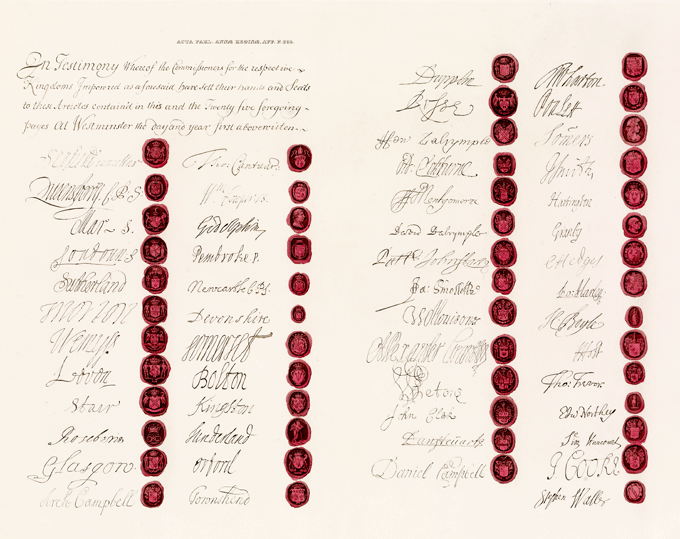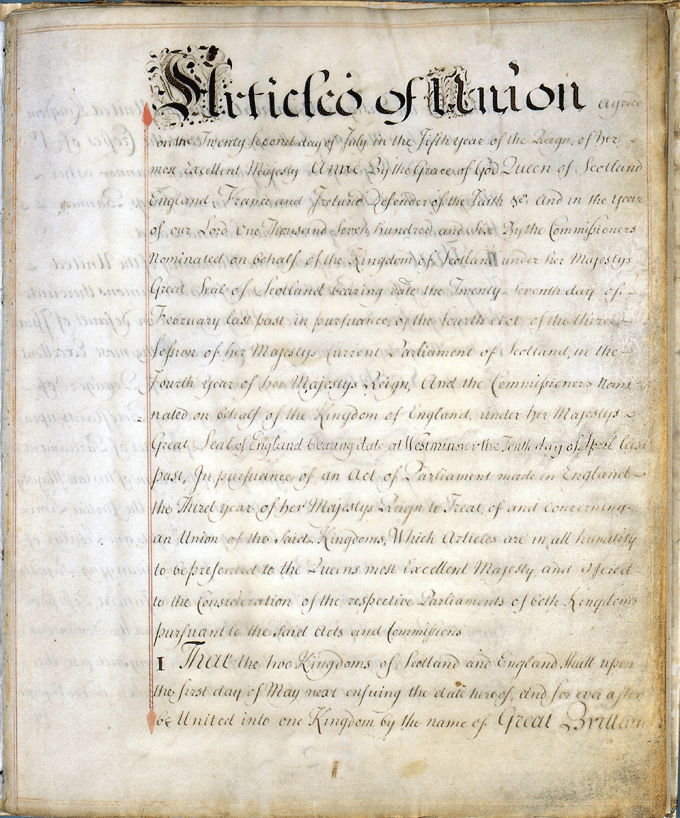| | Home | Resources | Schools Programme | Teachers | Site help | About us | Contact us | |
| You are here: Home > Resources >The Union of 1707 > The Articles of Union |
The Articles of UnionThree months later, the Articles of Union, the terms for a treaty, were agreed. | ||
The Presentation of the Articles to Queen AnneIn July 1706, the Articles of Union were presented to the Queen at a ceremony at St James’ Palace. The Earl of Mar wrote to his brother to describe the ceremony. The 25 articles were published, then debated and voted on article by article by both Parliaments. You cannot immagine how agreeable it was to everybody here Our concluding the treatie & delivering of it to the Queen, which was done very solemnlie. She summond us to meet at the Councill chamber at St James. We walkt throw the rooms from that to the room her Majesty was in to receave us where were all the Ladys & the Court & fforaigne ambassadors. One of us & one of the English walkt togither & so on, we on the left hand as we walkt but we were on the Queen’s right hand. The Keeper & our Chancellor made a speech when they delivered the books & then the Queen made a speech to us. (National Records of Scotland, Mar and Kellie papers, GD124/15/397/8) |
||
The Signatures to the ArticlesThe Scottish and English commissioners who had negotiated the terms of the treaty completed their task when they signed the finished Articles on 22 July 1706. In Testimony Whereof the Commissioners for the respective Kingdoms Impowred as aforesaid bare sett their hands and Seals to these Articles contained in this and the Twenty five foregoing pages At Westminster the day and year first abovewritten. The names of the Scottish commissioners are in columns 1 and 3, headed by the Earl of Seafield and Viscount Dupplin, and the English commissioners in columns 2 and 4, headed by the Archbishop of Canterbury and Lord Wharton. 
(Facsimile of the signatures of the Articles of Union (c) Crown copyright, National Records of Scotland) | ||
The Articles of Union
(The first page of the Articles of Union, National Records of Scotland, State Papers, reference SP13/209) This list summarises the 25 articles. Fifteen of them dealt with economic measures. A full but simplified list of the articles is also available as an Acrobat PDF file (550KB, opens in new window).
Rules of Government Rules of GovernmentArticle 1 On 1 May 1707, the two kingdoms of Scotland and England shall be united into one kingdom GREAT BRITAIN and the crosses of St Andrew and St George be joined and used in flags, banners, standards and ensigns at sea and on land. Article 2 The succession to the throne of Great Britain will pass to the Protestant heirs of Princess Sophia of Hanover and all Papists shall be excluded from the Crown of Great Britain. Article 3 The United Kingdom will be represented by one and the same Parliament to be called the Parliament of Great Britain. Articles 18-19 Scotland will keep its own separate laws, legal system and courts of law. Articles 20-21 The Royal Burghs of Scotland and those holding heritable jurisdictions i.e. posts and offices granted for life, will have their rights and privileges preserved after union. Articles 22-23 Scotland will be represented by 16 peers in the House of Lords and 45 members of Parliament in the House of Commons in the first Parliament of Great Britain. Scottish peers will have the same privileges as English peers. Article 24 After the Union, there will be one Great Seal for Great Britain but Scotland will retain use of the Great Seal of Scotland for matters relating to private rights or grants. The Scottish Crown, Sceptre and Sword of State and all Scottish public and private records will be kept and will remain in Scotland. Article 25 The final article revokes all previous acts that might operate against the union and confirms the full authority of law in passing the Act of Union. Rules of TradeArticle 4 All subjects of Great Britain will have freedom of trade within the United Kingdom and with her colonies. Article 5 All trading ships will be registered with Customs Officers in Great Britain. Article 6 Great Britain will operate the same trade regulations and be liable for the same customs and duties on imports and exports. Article 7 The level of excise duty on liquor set across England will operate throughout Great Britain. Article 15 Scotland will receive the sum of £398,085 10s sterling, known as the Equivalent:
Article 16 Great Britain will use the same currency. Coins minted in Scotland will have the same value as those minted in England. Article 17 Great Britain will use the same form of weights and measures. The Scottish system will be abolished and replaced with the English system. Tax RulesArticles 8-14 Scotland will pay
Scotland will not pay
|
|
|